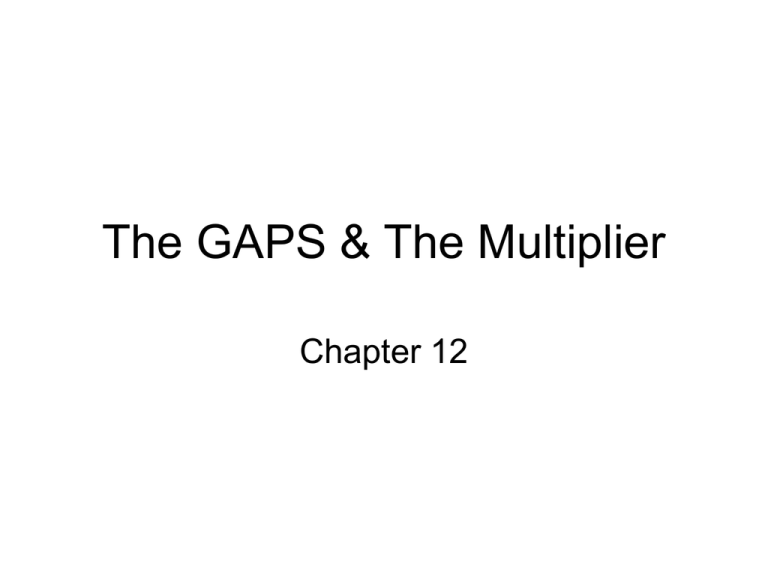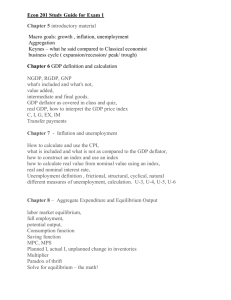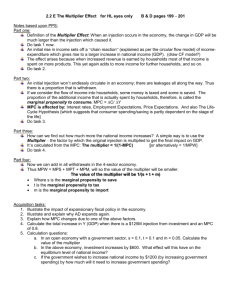
The GAPS & The Multiplier
Chapter 12
The Multiplier and Its
Applications
• Any change in spending (C, I, or G) will
set off a chain reaction, leading to a
multiplied change in GDP
GDP = C + I + G + Xn
How much the multiplied change is
depends on the MPC and MPS
Copyright 2002 by The McGraw-Hill Companies, Inc. All rights reserved.
12-13
Calculating the Multiplier
• Remember
MPC + MPS = 1, therefore, MPS = 1 - MPC
1
Multiplier = ----------------------1 - MPC
1
Multiplier = ---------------------MPS
Copyright 2002 by The McGraw-Hill Companies, Inc. All rights reserved.
Because the multiplier
(like C) deals with
spending, 1/(1-MPC)
is a more appropriate
formula)
12-14
Calculating the Multiplier
• The MPC is .5.
Find the multiplier
Copyright 2002 by The McGraw-Hill Companies, Inc. All rights reserved.
12-15
Calculating the Multiplier
(Continued)
• The MPC is .5. Find the multiplier
1
1
1
Multiplier = ---------------- = -------- = ----- = 2
1 - MPC
1 – .5
.5
Copyright 2002 by The McGraw-Hill Companies, Inc. All rights reserved.
12-16
Calculating the Multiplier
Step-by-Step Working of the Multiplier When MPC is .5
$1,000.00
$ 500.00
$ 250.00
$ 125.00
$ 62.50
$ 31.25
$ 15.625
$
7.813
$
3.906
$ etc.
$ etc.
$2,000.00
It is surely much easier to use the multiplier of 2
(2 X $1,000 = $2000) than to go through this
process and add up all the figures
Copyright 2002 by The McGraw-Hill Companies, Inc. All rights reserved.
12-17
Calculating the Multiplier
(Continued)
• The MPC is .75. Find the multiplier
Copyright 2002 by The McGraw-Hill Companies, Inc. All rights reserved.
12-18
Calculating the Multiplier
(Continued)
• The MPC is .75. Find the multiplier
1
1
1
Multiplier = ---------------- = -------- = ----- = 4
1 - MPC
1 – .75 .25
Copyright 2002 by The McGraw-Hill Companies, Inc. All rights reserved.
12-19
Applications of the Multiplier
• The Multiplier is used to calculate the
effect of changes in C, I, or G on GDP
GDP = 2,500; Multiplier = 3; C rises by 10
What is the new level of GDP?
GDPNew = GDPInitial + (Change in spending X Multiplier)
GDPNew = 2500 + ( 10 x 3)
GDPNew = 2500 + ( 30)
GDPNew = 2530
Copyright 2002 by The McGraw-Hill Companies, Inc. All rights reserved.
12-20
Applications of the Multiplier
• The Multiplier is used to calculate the
effect of changes in C, I, or G on GDP
GDP = X; Multiplier = 3; C rises by 10
What happens to GDP?
GDPNew = GDPInitial + (Change in spending X Multiplier)
GDPNew = X + ( 10 x 3)
GDPNew = X + ( 30)
GDP increases by 30
Copyright 2002 by The McGraw-Hill Companies, Inc. All rights reserved.
12-21
Applications of the Multiplier
• The Multiplier is used to calculate the
effect of changes in C, I, or G on GDP
GDP = X; Multiplier = 7; G falls by 5
What happens to GDP?
GDPNew = GDPInitial + (Change in spending X Multiplier)
GDPNew = X + ( -5 x 7)
GDPNew = X + ( -35)
GDP decreases by 35
Copyright 2002 by The McGraw-Hill Companies, Inc. All rights reserved.
12-22
Applications of the Multiplier
• How big is the multiplier (M)?
9
M = distance between the
equilibrium GDP and the fullemployment GDP / by the gap
8
Def lationary gap
C + I + G + Xn
7
6
5
4
3
2
M=2/2=1
1
2
1
2
3
4
5
6
7
8
9
Full-employment GDP
GDP (in trillions of dollars)
Copyright 2002 by The McGraw-Hill Companies, Inc. All rights reserved.
12-23
Applications of the Multiplier
• How big is the multiplier (M)?
M = distance between the
equilibrium GDP and the fullemployment GDP / by the gap
2,000
C + I + G + Xn
Inf lationary gap
1,500
1,000
500
M = 500 / 200 = 2.5
500
0
500
1,000
1,500
2,000
Full-employment GDP
GDP (in trillions of dollars)
Copyright 2002 by The McGraw-Hill Companies, Inc. All rights reserved.
12-24
Removing the Deflationary Gap
9
8
C1 + I1 + G1 + Xn1
7
C + I + G + Xn
6
To remove the deflationary
gap we raise aggregate
demand from C+I+G+Xn
to C1+I1+G1+Xn1
5
4
3
2
1
1
2
3
4
5
6
7
8
9
Full-employment GDP
This pushes equilibrium
GDP to $7 trillion and
removes the deflationary
gap
GDP (in trillions of dollars)
Copyright 2002 by The McGraw-Hill Companies, Inc. All rights reserved.
12-25
Removing the Inflationary Gap
2,500
2,000
C + I + G + Xn
1,500
C1 + I1 + G1 + Xn1
Inf lationary gap
1,000
This pushes equilibrium
GDP down to 1,000 and
removes the inflationary
gap
500
0
500
500
1,000
To remove the inflationary
gap we lower aggregate
demand from C+I+G+Xn
to C1+I1+G1+Xn1
1,500
2,000
2,500
Full-employment GDP
GDP (in billions of dollars)
Copyright 2002 by The McGraw-Hill Companies, Inc. All rights reserved.
12-26







